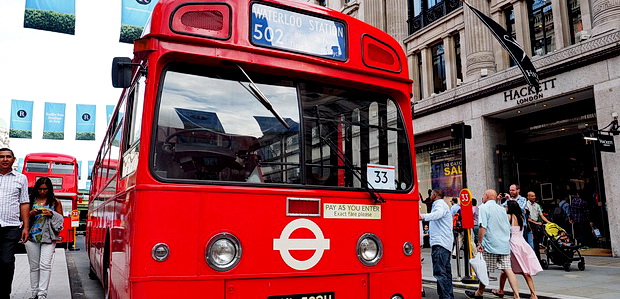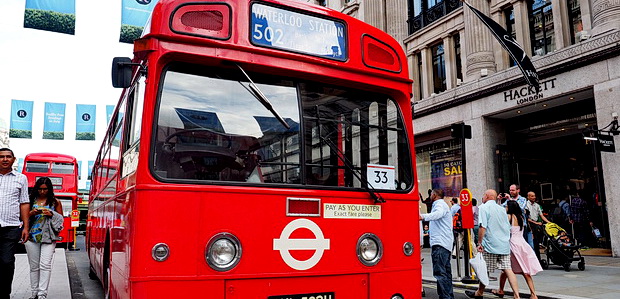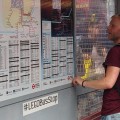
On Sunday, Regent Street in central London was pedestrianised and turned into an open bus museum, with a timeline of around 50 buses stretching from Oxford Circus down to Piccadilly Circus. And it was ace!
Billed as the Bus Cavalcade in Regent Street, the vent was part of London’s ‘Year Of The Bus’ celebrations.
At the northern end, you could see Transport for London’s newest bus, Boris’s baby, the 2012 Routemaster, along with hi-tech examples of electric, hydrogen and hybrid powered buses.
The weather was glorious and some people took full advantage of the traffic free zone!
Benches were placed on the normally busy Regent Street thoroughfare.
Heading south was like walking into the past. This natty green and yellow number was a Daimler Fleetline Experimental one-person operated bus from 1965.
An AEC Routemaster Coach from 1965.
AnAEC Routemaster bus from 1962, which was located next to the fabulous Lego Bus Stop.
Imber is an uninhabited village in part of the British Army’s training grounds on the Salisbury Plain
Routemaster detail.
On the left is a 1950 AEC Routemaster RM5 1959, with a 1958 Leyland Routemaster RML3 on the opposite side of the road.
A young driver takes the wheel.
Taking a closer look.
I loved this AEC BEA Coach from 1953.
I’m not sure what this foam-based activity was all about, but people seemed to enjoy it.
1952 AEC Regent III bus – RT2775 – complete with advert for BOAC (British Overseas Airways Corporation), a British state-owned airline created in 1940 by the merger of Imperial Airways and British Airways Ltd.
Delivered to London Transport in January 1952, this bus was selected, along with two others, to represent the British Travel and Holidays Association and London Transport, and was sent on a tour of the USA and Canada with the aim of promoting travel to Britain and the purchase of British products.
it was a lengthy tour too, visiting New York, Cincinatti, St Louis, Kansas City, Dallas, Sante Fe, Hollywood, San Francisco and then returning via Salt Lake City, Denver, Omaha, Des Moines, Chicago and Detroit, with a 2000-mile Canadian detour taking in Ottawa, Montreal, Perth, Toronto and London, Ontario
Conductor.
The curiously named Guy Arab II bus – G351 – a wartime utility bus from 1945.
AEC Regent from 1946.
Trolley Bus Q1 class of 1948.
Trolleybus logo.
Overhead connectors.
AEC pre-war RT from 1940. The London Bus Museum website gets particularly excited about this bus:
The famous RT1 is to London bus enthusiasts what Flying Scotsman is to the world of steam locomotives; RT1 was built in 1939 and was the forerunner of nearly 7,000 buses of its type which dominated the streets of London in the 1950s and 1960s.
Regarded by many as an icon, the RT-type bus was way ahead of its time to the extent that the last of them was not withdrawn from front-line service until 1979
I love the iconic Picture Post advertising.
AEC T-type coach from 1938 in a lovely two tone green finish.
AEC STL-type from 1937, with Branston Pickle advertising.
Front view.
Tree lopper (formerly STL1470) which was in service from 1936-1953.
The Leyland Cub C4. One of a fleet of 36 bought by LT, these coaches were in service from 1935-1953.
In service from 1931-1950, these single decker AEC Renown LT1076 buses were used for quieter routes or those with low bridges.
Posing for the cameras.
Grill detail.
LT 165 AEC Renown buses were in service from 1930-1949 and some of the first to be converted to diesel.
The bus was shown in wartime guise.
AEC NS-type motor bus registration YR3844, in service from 1926 to 1937 and initially built with an open top.
Top floor view.
Grill detail.
Side view.
Crowds taking photos.
Leyland LB5, 1924, known as the Chocolate Express.
AEC S-type registration XL8962, one of 928 S-Type buses built for the London General Omnibus Company by the Associated Equipment Company of Walthamstow between 1920 and 1927. This bus was recently sold at Bonhams for £281,500.
Tilling-Stevens XL1204 from 1922.
Looking north up Regent Street.
The rather stylish AEC S-Type, in service from 1922-1932.
AEC K-Type,a bus from 1920-1932 which established the layout of a modern bus.
Overall view.
AEC B-type (Battle Bus). One of only four surviving B-type London buses, B2737 was built at the AEC Works in Walthamstow in 1914 and could reach a top speed of 16 mph and seat 34 passengers.
At the outbreak of WW1, they were turned into Battle Buses to serve in the battlefields of France and Belgium.
The Leyland X2 Motorbus of 1908, this first bus designed specifically for use in the capital.
Only 60 were ever built.
A view near Piccadilly Circus.
London General AEC S-type double decker S454 (XL8962), built in 1922.
This bus once featured in an episode of the ‘On The Buses‘ TV series from the 1970s.
Leyland LB5 from 1924.
More details on all the buses in the Cavalcade can be found at the London Bus Museum.
More bus photos and features:
Photos from Stockwell Bus Garage Open Day, Sat June 21st 2014
Beautiful old Brixton buses at the Bus Cavalcade in Regent Street, London
Meet the Lego Bus Stop outside Hamley’s toy shop, Regent Street, London


